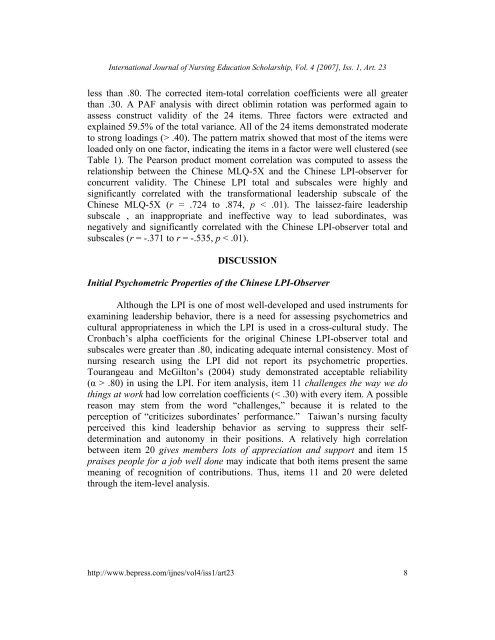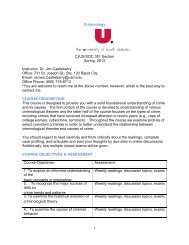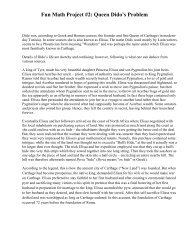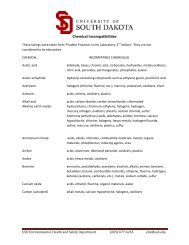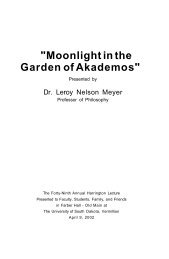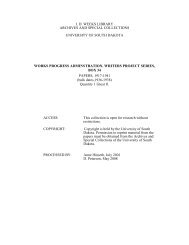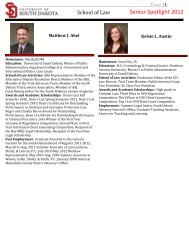Psychometric Properties of the Chinese Leadership Practices ...
Psychometric Properties of the Chinese Leadership Practices ...
Psychometric Properties of the Chinese Leadership Practices ...
Create successful ePaper yourself
Turn your PDF publications into a flip-book with our unique Google optimized e-Paper software.
International Journal <strong>of</strong> Nursing Education Scholarship, Vol. 4 [2007], Iss. 1, Art. 23<br />
less than .80. The corrected item-total correlation coefficients were all greater<br />
than .30. A PAF analysis with direct oblimin rotation was performed again to<br />
assess construct validity <strong>of</strong> <strong>the</strong> 24 items. Three factors were extracted and<br />
explained 59.5% <strong>of</strong> <strong>the</strong> total variance. All <strong>of</strong> <strong>the</strong> 24 items demonstrated moderate<br />
to strong loadings (> .40). The pattern matrix showed that most <strong>of</strong> <strong>the</strong> items were<br />
loaded only on one factor, indicating <strong>the</strong> items in a factor were well clustered (see<br />
Table 1). The Pearson product moment correlation was computed to assess <strong>the</strong><br />
relationship between <strong>the</strong> <strong>Chinese</strong> MLQ-5X and <strong>the</strong> <strong>Chinese</strong> LPI-observer for<br />
concurrent validity. The <strong>Chinese</strong> LPI total and subscales were highly and<br />
significantly correlated with <strong>the</strong> transformational leadership subscale <strong>of</strong> <strong>the</strong><br />
<strong>Chinese</strong> MLQ-5X (r = .724 to .874, p < .01). The laissez-faire leadership<br />
subscale , an inappropriate and ineffective way to lead subordinates, was<br />
negatively and significantly correlated with <strong>the</strong> <strong>Chinese</strong> LPI-observer total and<br />
subscales (r = -.371 to r = -.535, p < .01).<br />
DISCUSSION<br />
Initial <strong>Psychometric</strong> <strong>Properties</strong> <strong>of</strong> <strong>the</strong> <strong>Chinese</strong> LPI-Observer<br />
Although <strong>the</strong> LPI is one <strong>of</strong> most well-developed and used instruments for<br />
examining leadership behavior, <strong>the</strong>re is a need for assessing psychometrics and<br />
cultural appropriateness in which <strong>the</strong> LPI is used in a cross-cultural study. The<br />
Cronbach’s alpha coefficients for <strong>the</strong> original <strong>Chinese</strong> LPI-observer total and<br />
subscales were greater than .80, indicating adequate internal consistency. Most <strong>of</strong><br />
nursing research using <strong>the</strong> LPI did not report its psychometric properties.<br />
Tourangeau and McGilton’s (2004) study demonstrated acceptable reliability<br />
(α > .80) in using <strong>the</strong> LPI. For item analysis, item 11 challenges <strong>the</strong> way we do<br />
things at work had low correlation coefficients (< .30) with every item. A possible<br />
reason may stem from <strong>the</strong> word “challenges,” because it is related to <strong>the</strong><br />
perception <strong>of</strong> “criticizes subordinates’ performance.” Taiwan’s nursing faculty<br />
perceived this kind leadership behavior as serving to suppress <strong>the</strong>ir selfdetermination<br />
and autonomy in <strong>the</strong>ir positions. A relatively high correlation<br />
between item 20 gives members lots <strong>of</strong> appreciation and support and item 15<br />
praises people for a job well done may indicate that both items present <strong>the</strong> same<br />
meaning <strong>of</strong> recognition <strong>of</strong> contributions. Thus, items 11 and 20 were deleted<br />
through <strong>the</strong> item-level analysis.<br />
http://www.bepress.com/ijnes/vol4/iss1/art23<br />
8


